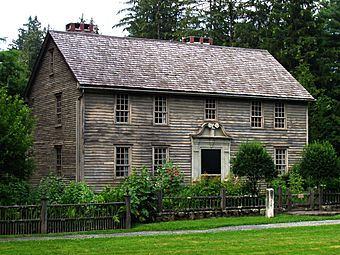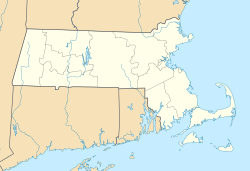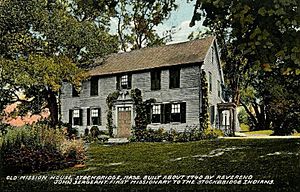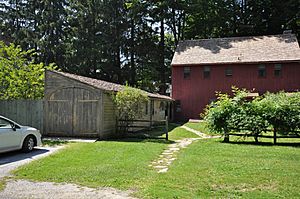Mission House (Stockbridge, Massachusetts) facts for kids
|
Mission House
|
|
|
U.S. Historic district
Contributing property |
|
 |
|
| Location | Stockbridge, Massachusetts |
|---|---|
| Built | c. 1742 |
| Architect | John Sergeant |
| Architectural style | Georgian |
| Part of | Main Street Historic District |
| NRHP reference No. | 68000038 |
Quick facts for kids Significant dates |
|
| Added to NRHP | November 24, 1968 |
| Designated NHL | November 24, 1968 |
| Designated CP | January 17, 2002 |
The Mission House is an old, important house at 19 Main Street in Stockbridge, Massachusetts. It was built around 1741-1742 by a Christian missionary for the local Mahican people. It is a National Historic Landmark, which means it's a very important historical place. It was named this in 1968 because it's a rare example of a colonial mission house. Today, it is a museum run by the Trustees of Reservations.
The town of Stockbridge started in the late 1730s. It was a special community for the Mahican people and missionaries. John Sergeant was the first missionary there, starting in 1735. His first house is no longer standing. The Mission House was built after he got married in 1739. It was built in the white community on a hill above the town. The house stayed in the Sergeant family until the 1870s. It survived many changes in the late 1800s.
In the 1920s, Mabel Choate bought the house. She owned the nearby Naumkeag estate. She moved the Mission House down into the valley. Mabel Choate and a landscape designer named Fletcher Steele fixed up the building. They filled it with furniture from the 1700s. They also designed gardens to look like colonial gardens. Choate opened the house as a museum in 1930. She later gave it, and Naumkeag, to the Trustees of Reservations. They still run both places as museums today.
Contents
The Mahican People and the Mission
Before British settlers arrived, the southern part of Berkshire County, Massachusetts was home to the Mahican people. Their communities changed a lot during the 1600s. Wars, diseases, and people moving made their groups smaller and more mixed. By the 1720s, they had sold most of their land. They lived peacefully on two pieces of land along the Housatonic River.
In the late 1720s, British missionary groups became interested in the Mahicans. They wanted to teach them about Christianity. This was also to prevent influence from Catholic New France. A group led by the governor of the Province of Massachusetts Bay, Jonathan Belcher, managed this effort. In 1730, Belcher suggested creating a town on Mahican lands. He also suggested that London missionary groups pay for a mission there. Money was set aside for this plan in 1733.
In 1734, people from the Northampton area met to plan the mission. John Sergeant, who had just finished at Yale College, agreed to help. He spent time with the Mahicans that fall. After talks with Governor Belcher and Mahican leaders, they agreed to start a mission in 1735. Sergeant became a minister for them. He moved to the Mahican lands right away and began preaching and baptizing people.
In 1736, the Province of Massachusetts Bay officially gave the Mahicans a township. It was six square miles (16 km2) in size. This area became Stockbridge in 1739. The plan included land for the minister and schoolteacher. It also said that four English families should live there. They were meant to show a Christian way of life to the native people. John Sergeant built a simple house in the township. The Indian village grew around this area. It included a meeting house used as a church and school.
History of the Mission House
In 1739, John Sergeant married Abigail Williams. She was seventeen and the daughter of one of Stockbridge's English settlers. Abigail wanted to live outside the village. So, Sergeant had a new house built on Prospect Hill. This is the house we call the Mission House today. It overlooked the village. We are not sure exactly when it was built. Sergeant got the land in 1739, and the house was finished by 1742.
The Sergeants lived there until John Sergeant died in 1749. Abigail remarried and later moved out of the house. But the house stayed in the family. She returned to it after her second husband died. She lived with her son's family until she passed away in 1791. Jonathan Edwards, a famous minister, took over from Sergeant. He became the missionary to the Mahicans, who were also called "Stockbridge Indians." Edwards lived in the first house Sergeant built. That first house is gone now. A sundial near 23 Main Street marks its old location.
Sergeant's second house stayed in his family until 1879. Then, it was sold to David Dudley Field, Jr.. He was a lawyer from New York City. Field bought about 115 acres (47 ha) of land. He built a large summer house there. He rented out the Mission House to friends for several summers. Later, the Mission House fell into disrepair. In the 1920s, Mabel Choate saved it. She was the daughter of New York lawyer Joseph Hodges Choate. She owned the nearby Naumkeag estate. She wanted to make the Mission House a museum to honor her parents.
Around 1926, Choate bought the Mission House. The house was taken apart, and each piece was carefully numbered. In 1927, she bought the land at 19 Main Street where the house is now. This spot used to be where the Stockbridge Casino stood. She sold the casino building for $1. It was moved to its current spot east of town. It is now home to the Berkshire Theatre Festival. In 1928, the Mission House was rebuilt in its new location. Landscape designer Fletcher Steele guided this work. The land where the house first stood is now the site of the Roman Catholic National Shrine of The Divine Mercy.
The house's gardens were created between 1928 and 1932 by Fletcher Steele. He also did a lot of work on Naumkeag's gardens. Mabel Choate chose furniture for the house that fit the Sergeant period. The house opened as a museum in 1930. She gave the house and its land to the Trustees of Reservations in 1948. She also left part of her collection to the museum in her will.
Mabel Choate's gift to the museum included a two-volume Bible. This Bible was given to the Mahicans in 1745 by Francis Ayscough. In the 1930s, Choate convinced the elders of the Stockbridge-Munsee tribe to sell her the Bible. This tribe is the successor to the Mahicans. Tribe members were unhappy about the sale after it happened. But nothing was done. The tribe lost track of the Bible until members saw it in the museum in 1975. After talks, the Trustees of Reservations returned the Bible to the tribe in 1991.
House and Gardens Layout
The Mission House now sits on a piece of land about 0.4 acres (0.16 ha) in size. The house has a common Georgian style layout. It has a central hall with rooms on either side. A parlor (living room) is on the left, and a kitchen is on the right. Both rooms have fireplaces. A stairway in the central hall leads to the second floor. Behind the parlor is an office. This is where Sergeant would have met with the Mahican people.
One special feature is a second entrance on the right side of the house. A narrow hallway runs from this entrance to the office. This allowed Sergeant's Mahican visitors to reach his office without going through the front of the house. The front door has a very well-preserved pediment. This is a triangular shape above the door, common in the Connecticut River valley.
The property has several smaller buildings. These were mostly built during the restoration time. A small, one-room wooden building in the southwest corner is the visitor center. Behind the main house is a long, one-story building. It holds museum exhibits, storage, and utility areas. A 25-foot (7.6 m) grape arbor connects it to the house. Northeast of the house is a large barn-like building. It has event spaces and an apartment for a caretaker.
Fletcher Steele designed the gardens and outbuildings. He wanted them to look like a colonial garden. He used ideas from George Washington's estate at Mount Vernon. He imagined a place where "a hundred forms of industry were carried on." Rows of vegetables, fruit trees, and bushes were planted. Flowers were added for beauty. Spaces were made for outdoor work, like chopping wood or making butter. Steele also arranged the outbuildings to give the homeowners a private place to relax.
The house was named a National Historic Landmark in 1968. It was also listed on the National Register of Historic Places. It holds a collection of American furniture and art from the 1700s. You can visit the Mission House on summer weekends or by making an appointment.
More to Explore





